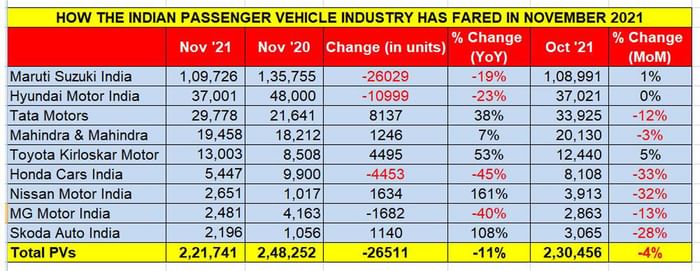When the top two players in the passenger vehicle market, which together command a near-61 percent market share, record poor sales, it is imperative that overall industry numbers will be impacted. Therefore, it comes as no surprise that November 2021 PV sales are in the red.
A quick analysis of nine carmakers whoreleased their official sales numbers for November 2021 reveals that total sales, at 2,21,741 units, are down a sizeable 11 percent year on year (November 2020: 2,48,252) and there is also a month-on-month sales decline of 4 percent (October 2021: 2,30,456).
- Tata continues to post sales growth
- Toyota sales climb 53 percent year on year
Maruti Suzuki India: 1,09,726 units / -19 percent
Maruti Suzuki India has reported domestic market sales of 1,09,726 PVs in November 2021, down 19 percenton year-ago sales of 1,35,775 units. Despite having a strong order book of an estimated 2,00,000 units, the continuing shortage of electronic components because of the semiconductor crisis is hampering better sales for the PV market leader.
Other than the utility vehicle segment, Maruti Suzuki sales have taken a hit. UV sales last month were 24,574 units, up 4.2 percent (November 2020: 23,753). The entry level Alto and S-Presso combine sold 17,473 units, which marks a sharp decline of 22 percent (November 2020: 22,339).
Poor sales of the usually high-selling seven models comprising the Wagon R, Baleno, Swift, Celerio, Dzire, Ignis and Tour S added to the overall decline. At 57,019 units, their sales last month were down 25.6 percent (November 2020: 76,630). The Eeco van too is feeling the heat: the 9,571 units sold last month are down 14.4 percent.
Hyundai Motor India: 37,001 units / -23 percent
Hyundai Motor India sold a total of 37,001 units last month, which constitutes a marked 23 percent sales decline (November 2020: 48,000). Month-on-month growth is flat, considering 37,021 units were sold in October 2021.
Tata Motors: 29,778 units / 38 percent
Tata Motors is on a roll. The company has notched the best growth among the nine carmakers here. With 29,778 Tata PVs being bought last month, the YoY growth is a robust 38 percent(November 2020: 21,641). The total comprised 28,047 IC-engine cars and 1,751 electric vehicles. While the ICE cars notched 32 percent growth (November 2020: 21,228), the surge in demand for Tata EVs is reflected in the 324 percent increase in EVs (November 2020: 413), albeit on a low base. However, when comparing November sales to October 2021’s 33,925 units, there is a 12 percent month-on-month sales decline.
Mahindra & Mahindra: 19,458 units / 7 percent
At fourth place in the pecking order, Mahindra & Mahindra has 19,458 units to its credit and posted 7 percent YoY growth (November 2020: 18,212). Its utility vehicles accounted for 19,384 units and clocked 8 percent growth (November 2020: 17,971). Overall PV growth would have been better if not for the poor sales of cars and vans – just 74 units and down 69 percent on year-ago sales of 241 units.

Veejay Nakra, chief executive officer, automotive division, M&M, said: “Our growth in SUVs continues with an 8 percent increase in November. The demand remains strong across our product portfolio of SUVs, pickups, and small commercial vehicles. Momentum in exports continues with a 90 percentgrowth. The issues around semiconductor-related parts continue to remain a challenge for the industry. We are monitoring the situation closely and taking appropriate steps.”
Toyota Kirloskar Motor: 13,003 units / 53 percent
Among the few strong performances came from Toyota Kirloskar Motor with 13,003 units, registering 53 percent growth (November 2020: 8,508) and 5 percent MoM growth (October 2021: 12,440).
Commenting on the numbers,V Wiseline Sigamani, associate general manager (AGM), sales and strategic marketing, TKM said, “Demand from the market continues to be strong which is duly reflected in our booking orders and we are trying our best to cater to these orders. Spike in both demand and orders can be attributed to the popularity our products enjoy amongst our customers and has been further aided by the recent product refreshments, including the launch of the new Legender 4x4 and the Innova Crysta limited edition.”
Growth outlook continues to be grim
Given that Maruti Suzuki, the bellwether of the Indian PV industry, has confirmed that its production in December 2021 will be 15-20 percent below regular levels (similar to November), expect December numbers from the market leader to be similar territory. Which is a pity because it is understood that the company has a sizeable backlog of orders (estimated at over 1,50,000) but the vexing issue of shortage of electronic components because of the semiconductor crisis remains a bugbear.
In a usual year’s December, car buyers prefer to shift their purchase decision to January of the new year to avail of a new model year but given the massive on-ground supply-demand mismatch, consumers just might hasten to buy what they get.
Also see:
Tata Motors on course for record sales in FY2022
Mercedes Benz delivers over 1,000 cars under its direct-to-customer retail model
Chip shortage: Maruti Suzuki anticipates drop in production in December



Comments
Member Login
Personal Details
No comments yet. Be the first to comment.